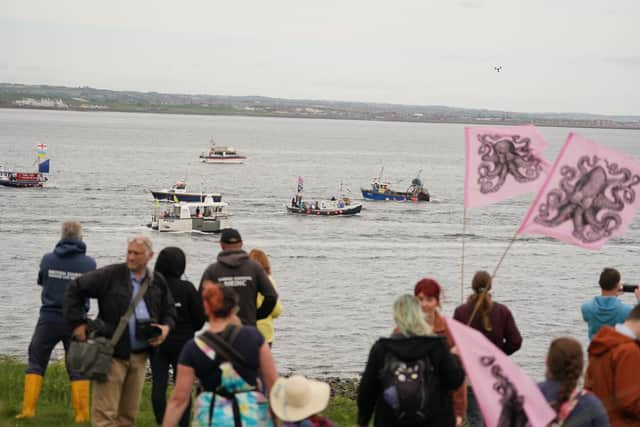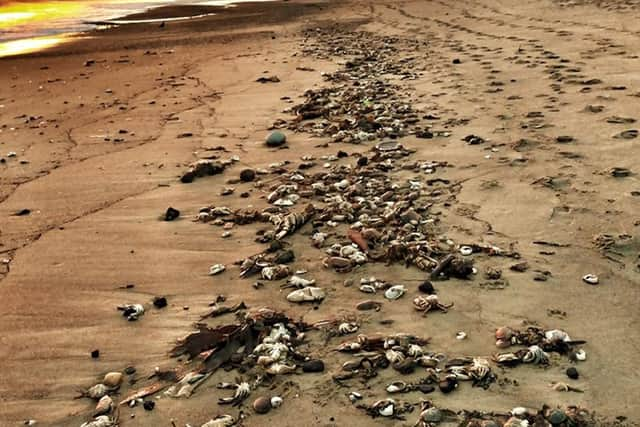Teesside crab deaths: what caused thousands of crustaceans to die - why is an independent panel being launched
and live on Freeview channel 276
An independent panel will be set up to investigate the deaths of thousands of dead crabs and lobsters that were washed ashore onto North Sea beaches last year, the UK government has announced.
Mass numbers of dying crustaceans were found along parts of the north-east coast of England between October and December 2021. There were distressing scenes of large numbers dead on beaches with fishing crews warning that sparse catches offshore following the event was “catastrophic” for their livelihoods.
Advertisement
Hide AdAdvertisement
Hide AdChief scientific adviser from the Department for Environment, Food and Rural Affairs (Defra), Professor Gideon Henderson, said the deaths were “unusual” and that “it is important we understand its cause.”
The panel will consider the impact of dredging around a freeport development in Teesside and the presence of pyridine, a chemical pollutant, among other potential causes, Defra said.


What happened on the Teesside and North Yorkshire coast?
Residents of coastal communities close to the mouth of the River Tees have been raising the alarm over the deaths of crustaceans since autumn last year.
An initial report by Defra blamed a naturally occurring algal bloom. But independent researchers blamed chemicals released by dredging operations linked to the development of the government’s flagship freeport at the mouth of the Tees.
Advertisement
Hide AdAdvertisement
Hide AdThe development on Europe’s largest brownfield site is expected to bring as many as 18,000 new jobs to the area. But some fear the extensive demolition, rebuilding and dredging work has disturbed pollutants that have lain dormant in the area and the surrounding seabed for decades.
Earlier this month the chair of the House of Commons environment select committee called for an urgent investigation into whether dredging had caused the deaths.
However, Defra stopped short of granting the request of Sir Robert Goodwill, MP of Scarborough and Whitby, to minimise dredging while the investigation took place.
Joe Redfern, secretary of Whitby Commercial Fishing Association, told Defra’s select committee that he thinks further dredging could bring an end to the North East fishing industry. He believes it is “undoubtable” that dredging and pyridine have played a part in the die-offs.


What have investigations found to have caused the deaths?
Advertisement
Hide AdAdvertisement
Hide AdAn official investigation into the incident was led by Defra and it pointed the finger at an algal bloom as the likely cause. It concluded it was unlikely that dredging, chemical or sewage pollution or animal disease had been the cause.
However, subsequent research by academics, backed by the fishing industry, suggested the incident could have been caused by industrial pollutant pyridine, possibly from dredging in the mouth of the River Tees to maintain channels for port traffic.
There have been calls for a halt to dredging for the new Teesside freeport pending a full analysis of the situation.
In a letter to the parliamentary Defra’s committee, which has been examining the issue, fisheries minister Mark Spencer said an independent group would be established to assess the evidence around the incident and consider all explanations. This would include the possible roles of algal blooms, dredging and pyridine.
Advertisement
Hide AdAdvertisement
Hide AdMr Spencer said that Professor Henderson, who has not previously been involved in considering this issue, would liaise with the government chief scientist Sir Patrick Vallance to establish the independent group.
It would consider the findings of the Defra-led investigation published in May 2022 and subsequent analysis from university researchers.
What has been said about the further research?
Mr Spencer said: “I recognise fishing communities in the North East want as thorough an assessment as possible into the crab and lobster deaths last year. Defra’s investigation concluded that the most likely cause was an algal bloom, but we have always recognised this is a complex area of science and have remained open to further research.
“That’s why it is right that all the evidence is now assessed by independent experts and I look forward to receiving their advice.”
Advertisement
Hide AdAdvertisement
Hide AdProfessor Henderson commented that the “death of a large number of crustaceans last year in north-east England was unusual” and the causes have been “assessed and informed with a wide range of measurements, by Government agencies and by university researchers, with more than one explanation put forward to explain the deaths.”
He added: “The increased sea life mortality has important consequences for local communities and it is important we understand its cause.”
Comment Guidelines
National World encourages reader discussion on our stories. User feedback, insights and back-and-forth exchanges add a rich layer of context to reporting. Please review our Community Guidelines before commenting.
